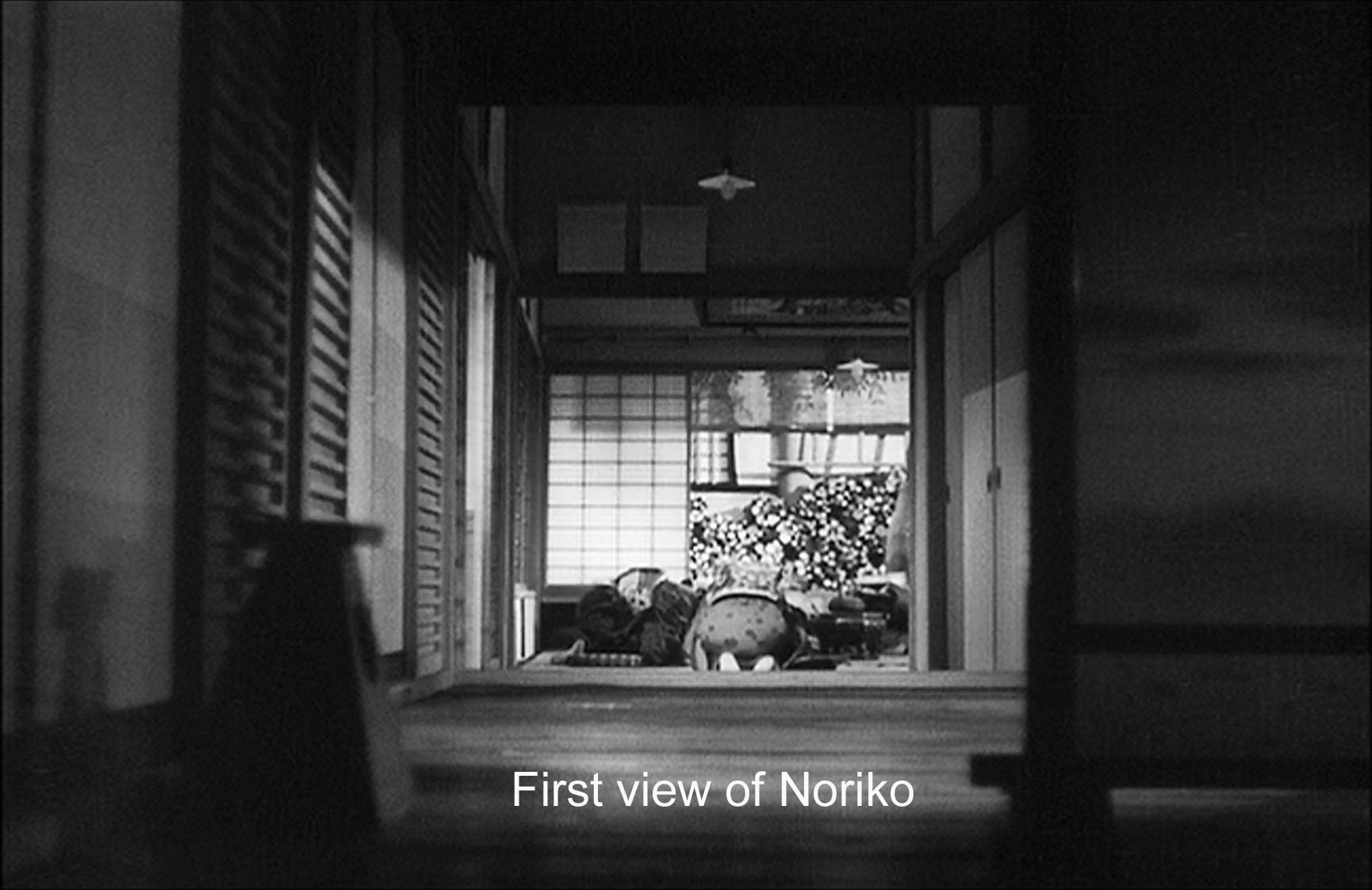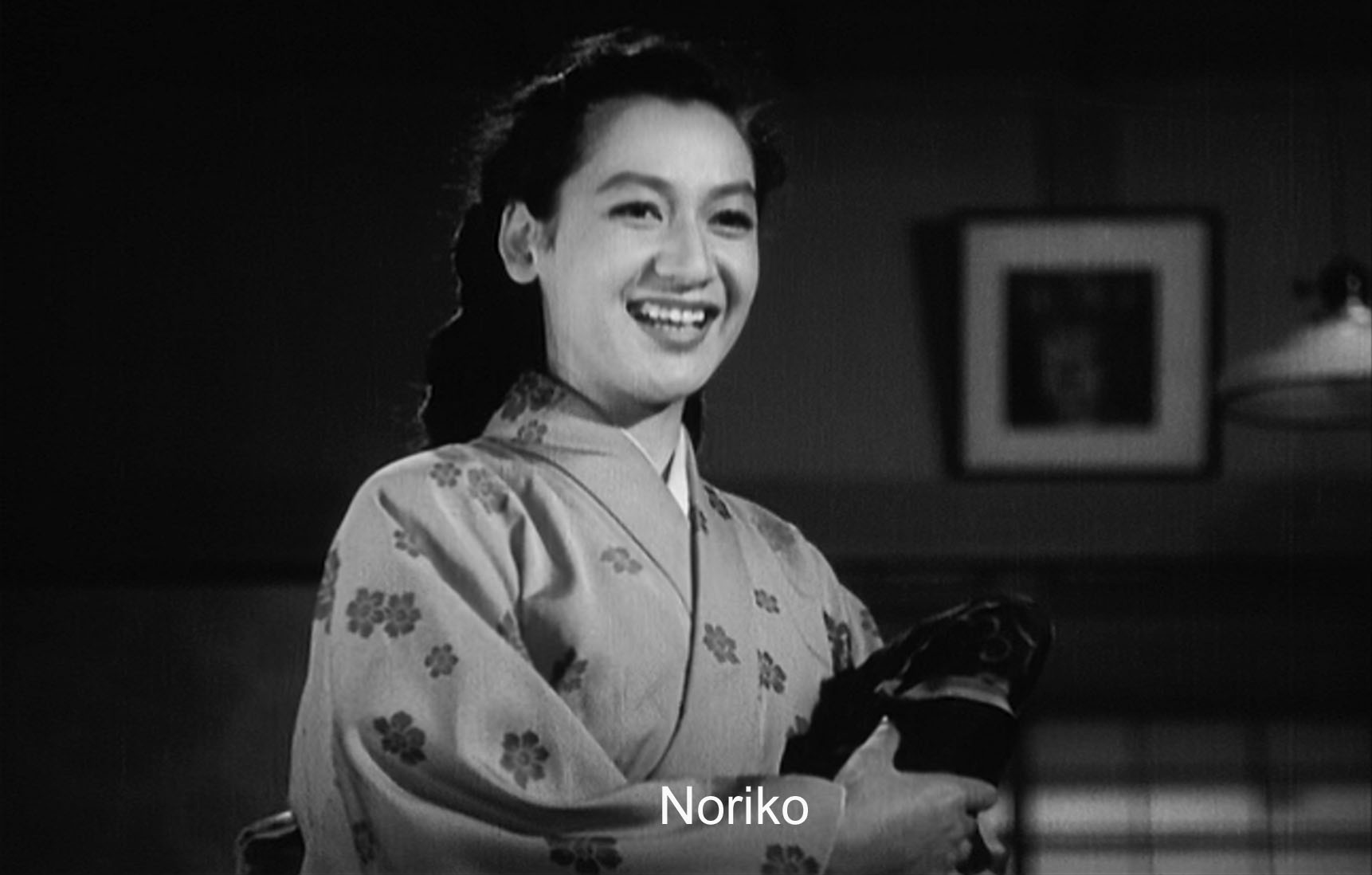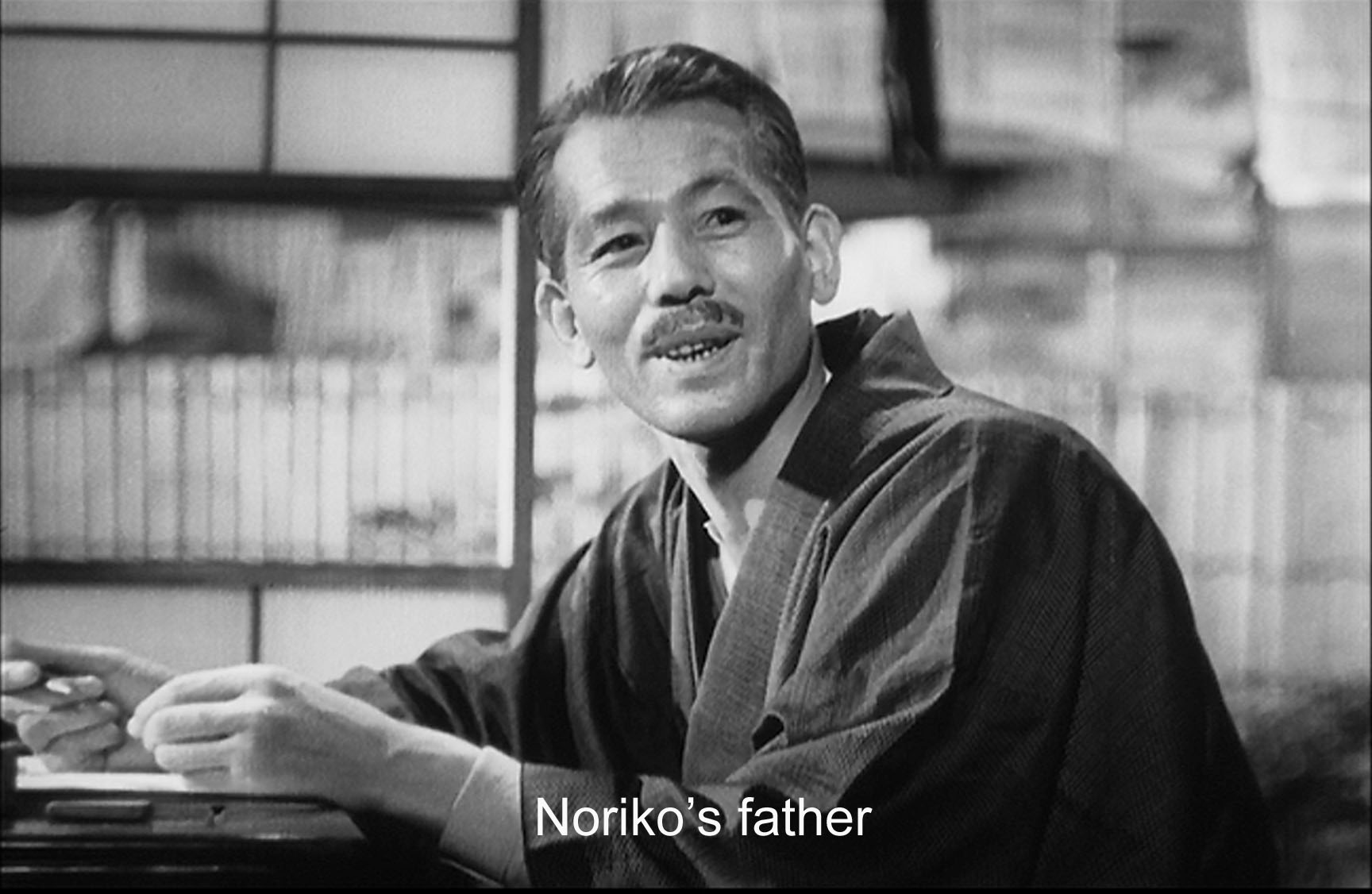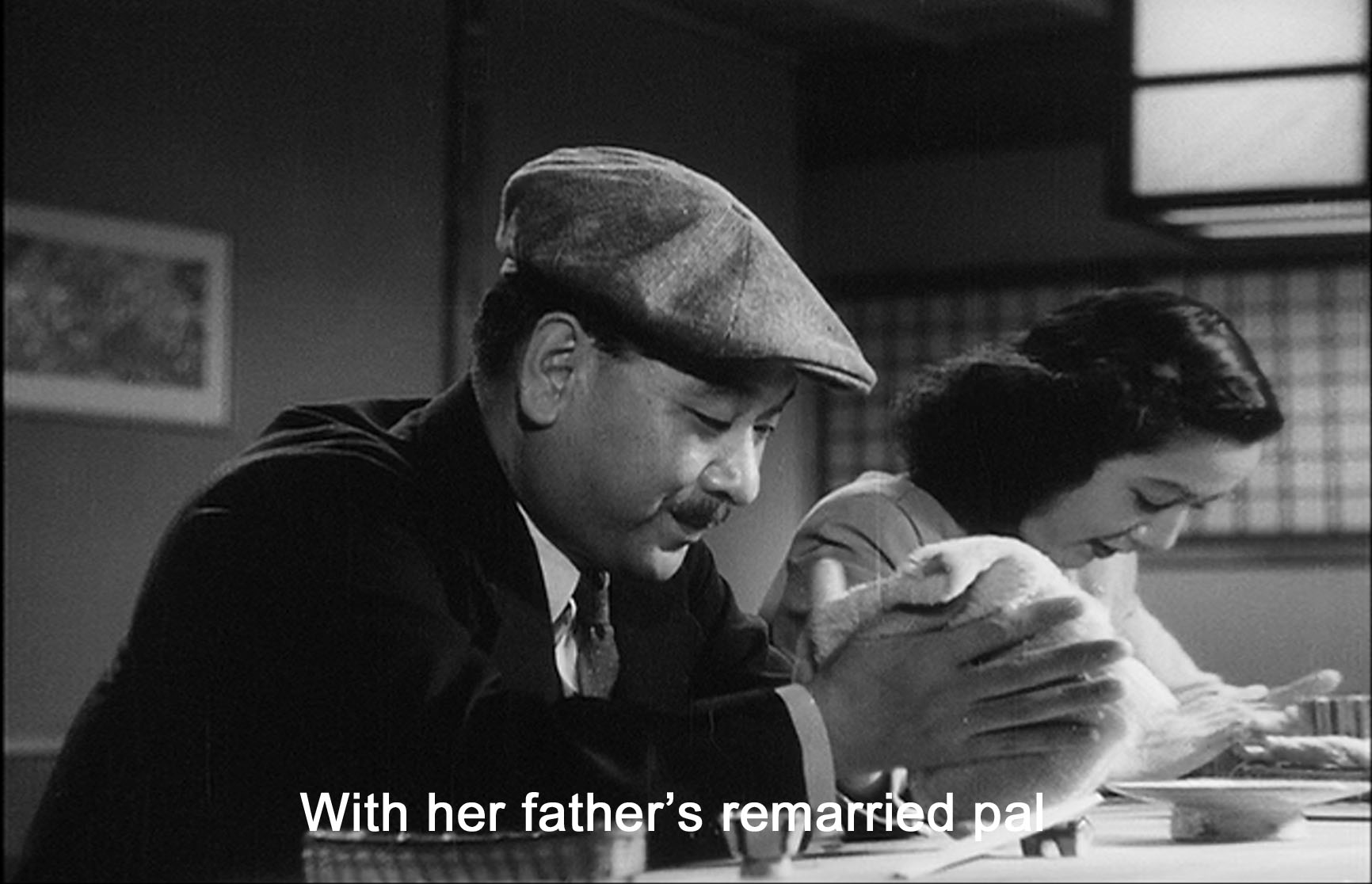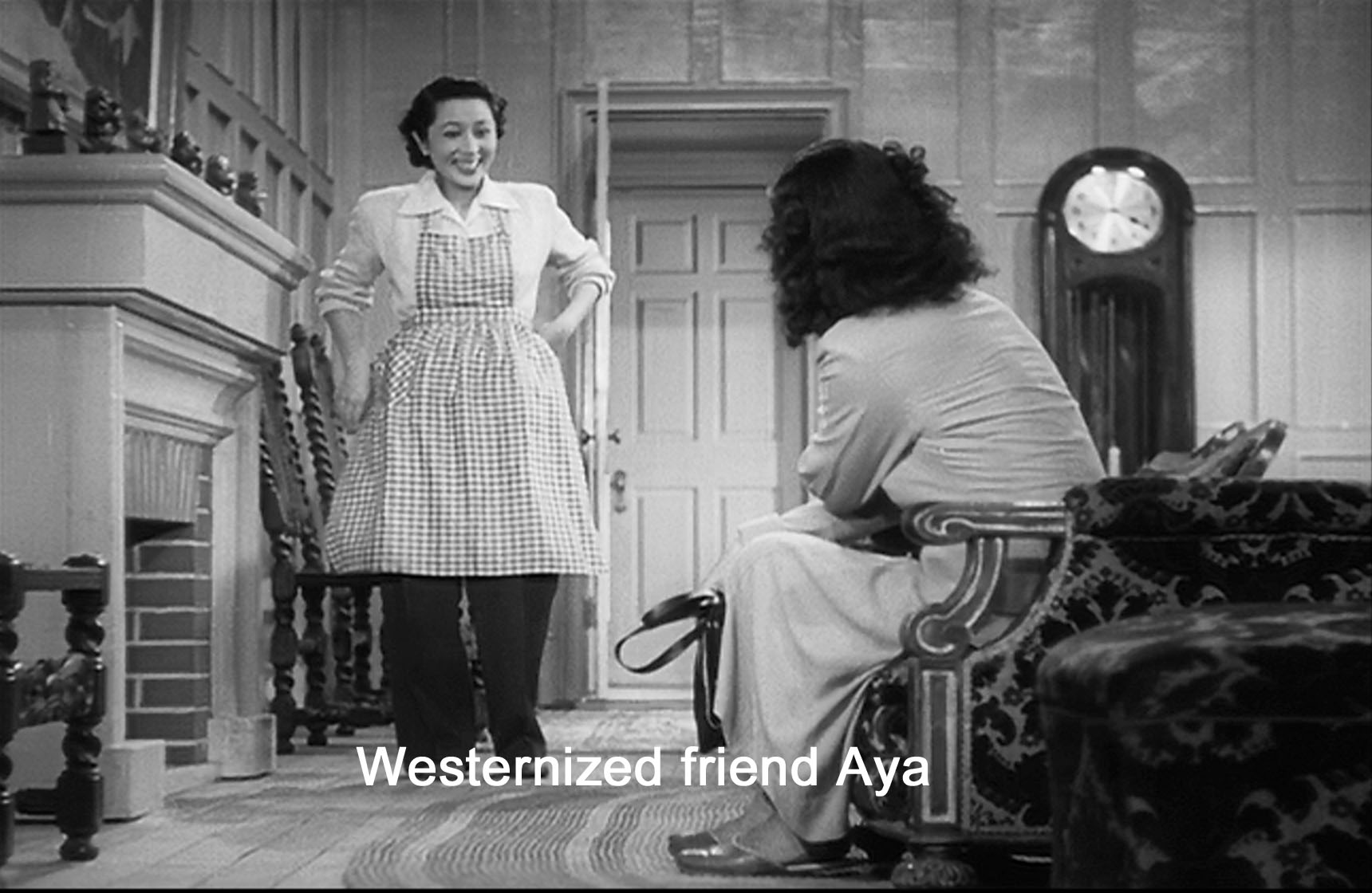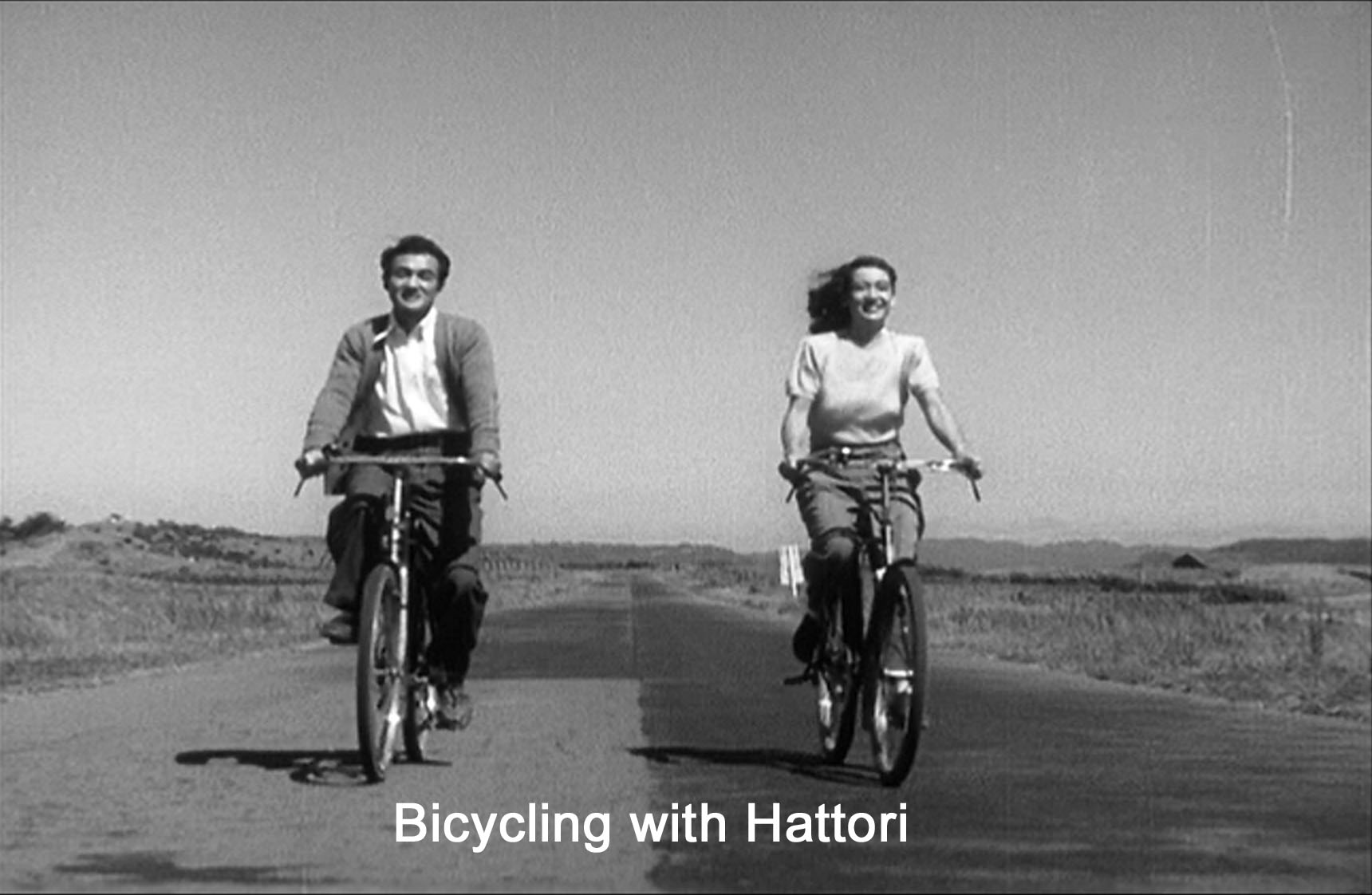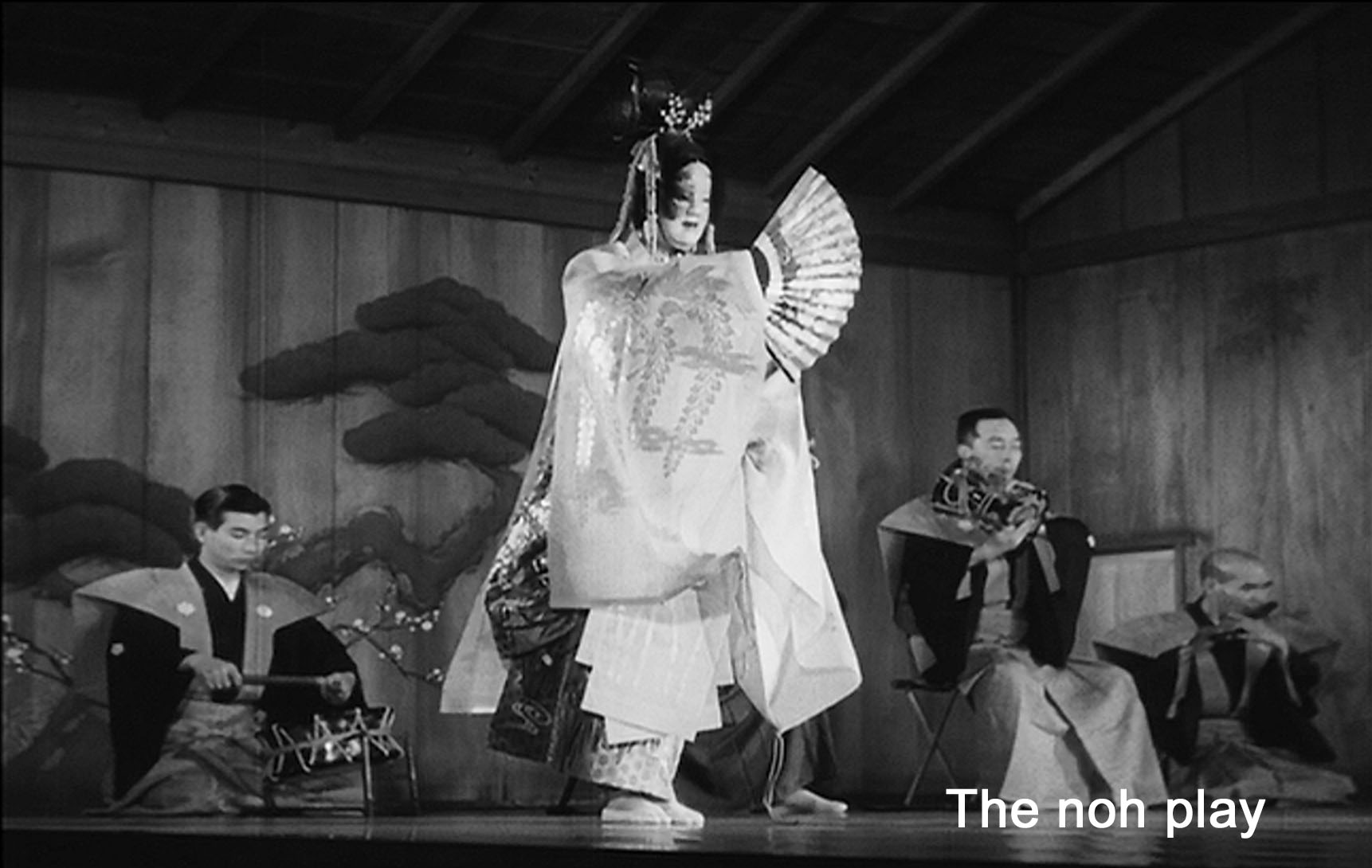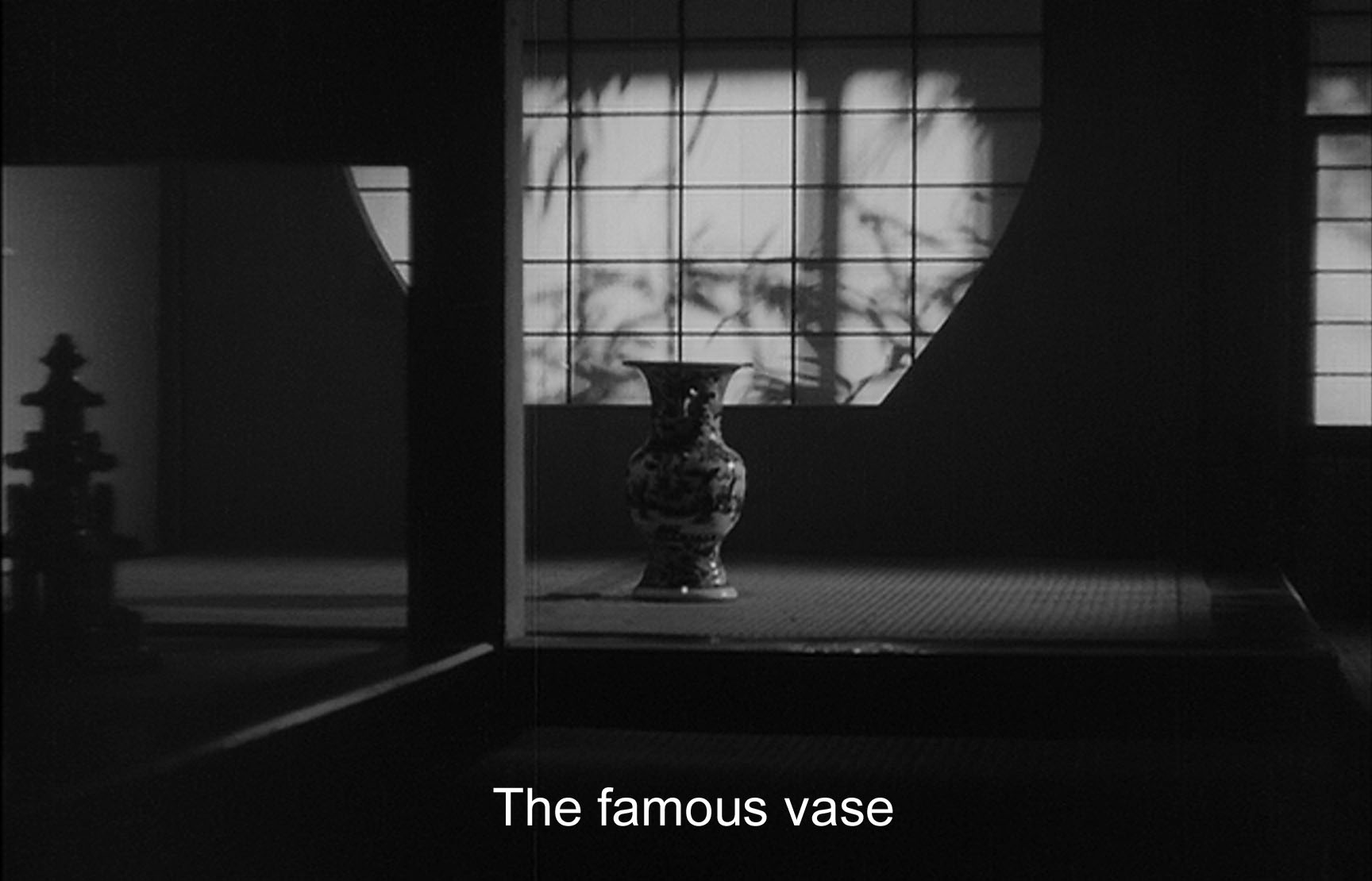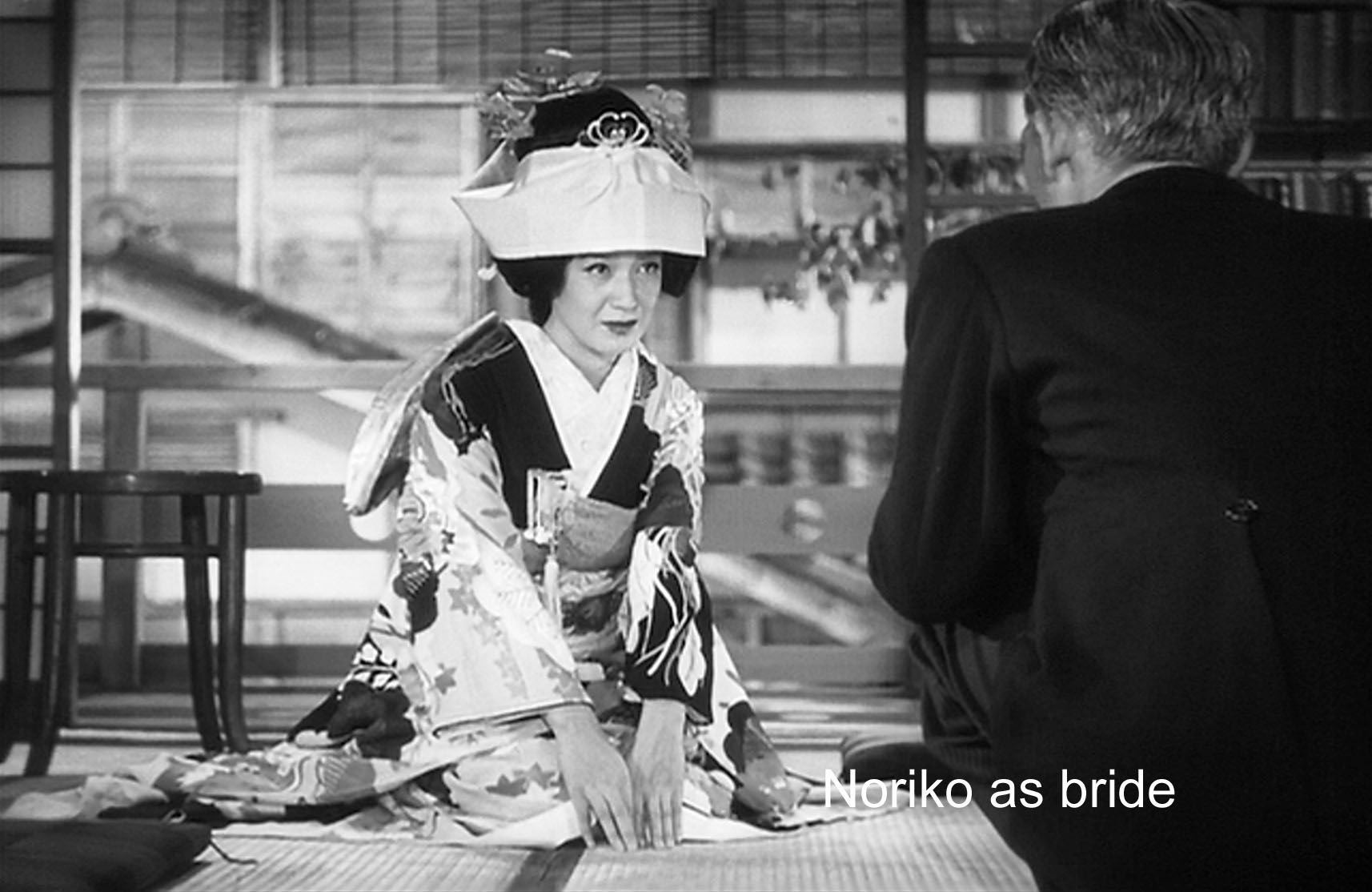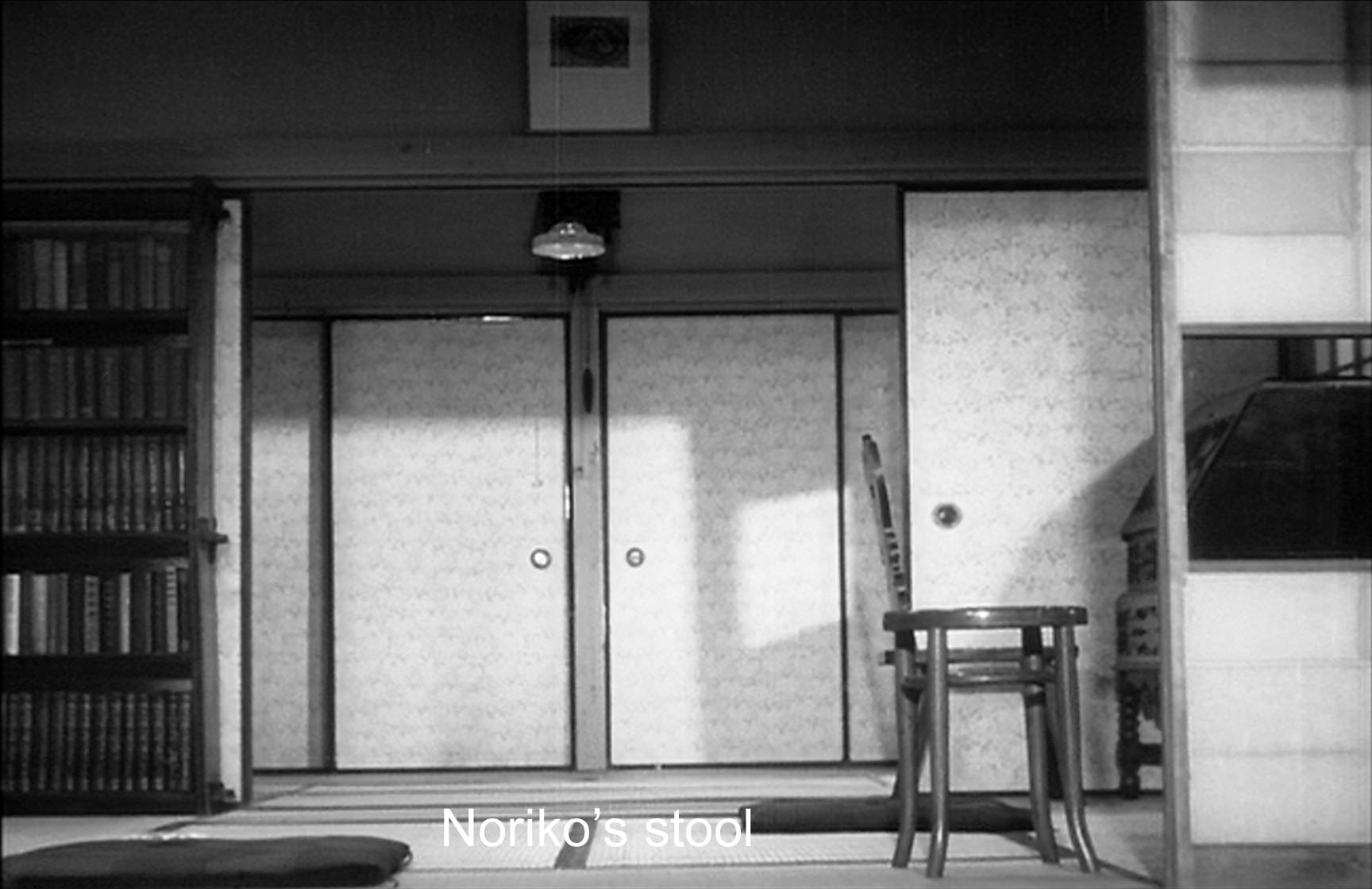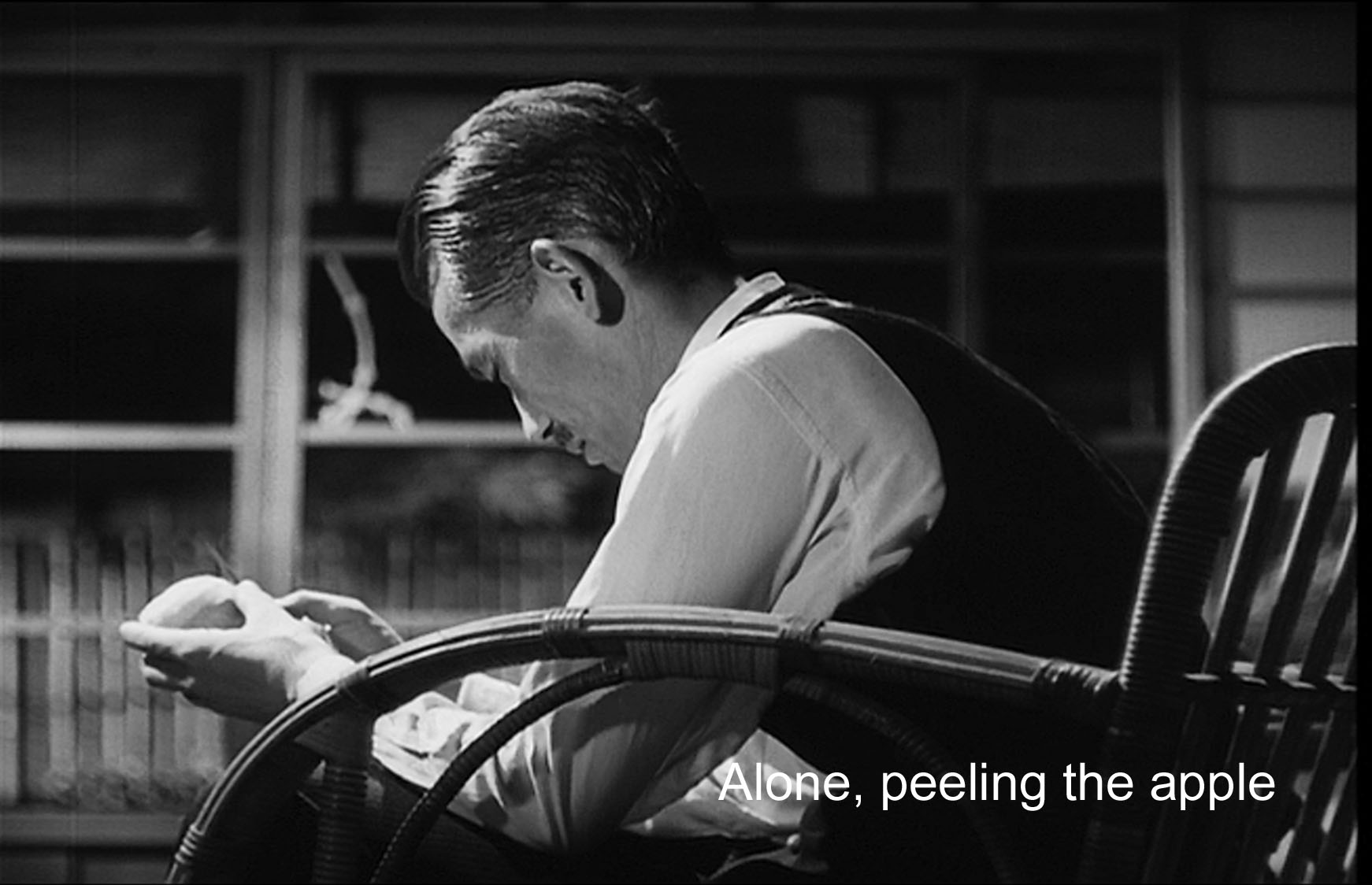Late Spring is a simple story—or is it? 56-year-old Professor Somiya (Chishu Ryu) and his 27-year-old daughter, Noriko (Setsuko Hara with whom Ozu made several films) are living very comfortably together. In order to get the daughter to marry, the professor pretends that he will himself marry. And she gets married. End of story.
There are at least two ways to read these events. As Roger Ebert, for example, sees it, the film shows a pesky, meddling aunt (Haruko Sugimura) pushing father and daughter into breaking up their cozy household and tricking the daughter into an arranged marriage. Each makes a sacrifice. He lies, pretending that he will remarry. She lies, pretending that she is looking forward to this marriage more or less forced on her. Ebert concludes that the result of these misguided sacrifices is lifelong unhappiness, and he may be right. As for marriage, the father tells her that he often found his wife weeping in the kitchen and that it may take her five or ten years to find happiness in marriage. As for motherhood, Noriko’s obnoxious nephew suggests that motherhood is no picnic, either.
From this point of view, my friend Maril Meeks Monaco writes me, “That Noriko, although deeply wounded by her father’s insensitive betrayal, could with such profound grace, apologize to her father for being ‘selfish’ and causing him to ‘worry,’ and by act of will, make a choice not only to marry, but to marry someone she did not know, much less love, rather than be ‘resigned’, shows a person of extraordinary strength of character.” Or someone trapped in the web of Japanese tradition of absolute obedience and servitude to parents.
From a psychoanalytic point of view, Noriko has it made in the shade. Her mother is out of the picture, and she has her father all to herself. She can mother him, treating him as a child, and she can be a child to him so that he becomes a protective, loving father. And all this without sex and the complications sex involves. She can remain virginal and innocent—guilt-free. Naturally, when her father says he will remarry, bringing both sexuality and another woman into the house, she is both hurt and outraged. “Why can’t we go on just as we are?,” she says. Why indeed?, according to Ebert, my friend, and others.
Alternatively, I think, and most critics think, that Ebert has it wrong. Her father and her aunt recognize a truth. She is twenty-seven, in “late spring,” getting old for marriage. Her cozy situation with her father cannot continue forever. When he dies in say, twenty years, she would be left alone, and who would provide for a solitary, aging woman with no money but what a professor could leave her? Her fanciful effort to become a stenographer like her self-sufficient friend Aya (Yumeji Tsuioka)—that goes nowhere. And Aya, her friend, says, after the wedding, that her father did the right, even noble thing by pushing her into marriage.
Her friend and her aunt both recognize—and Ozu shows us—that there is something not quite right about her relation with her father. In some ways, she is like a wife to him, buying his shirt collars, fixing his tea, sake, and dinner, doing his laundry, taking his coat off when he comes home, and so on. But she is also like a mother, telling the boys, as it were, the professor and his assistant, that they can’t play mah-jongg until they finish their overdue manuscript. In Kyoto she gets him his toothbrush and his gargle water; she turns off the light so that they can go to sleep (on adjoining futons).
To appreciate the movie fully, I think we need to take into account a host of details, like a meter reader interrupting that professor-father’s preparation of a manuscript or a reference (practically the first dialogue in the film) to cutting down a man’s trousers to fit a boy or long shots after a crucial conversation of an irrelevant vase, and so on. Then there are Ozu’s famous “pillow shots” that often intervene to break up normal cutting with an intermediate shot. And there is a peculiar conversation about cutting pickled radishes.
Certainly some of these details introduce the contrast of traditional Japanese ways to the modern and western, especially the American. This is the theme most critics focus on. The film was made during the American occupation, and it shows it. The film scarcely mentions World War II, but the hardships of the war have created a health problem for the heroine, Noriko. We hear of her “blood count” and loss of weight. Apparently, she spent a year or two in a sanatorium (TB?). Also many men have been killed, and the shortage of potential husbands is another reason she has not married.
Throughout the movie, signs are both in Japanese and English. Ozu starts the film with shots of a train station and train tracks (with a station gong on the sound track, but no train). Later, we will have a long train ride, trains being one of Ozu’s favored symbols for the rush and push into modernity. (Will Noriko sit down?, her father asks. I read this puzzling little conversation as standing for, Will she accept modernity? Or will she be traditional and do as her father wishes? She sits down by him.)
As for Americanization, on this trip to Tokyo, we see in the background a Time-Life building and a Bible House. Noriko and the professor’s assistant Hattori (Jun Usami) ride bicycles to the beach. The way that Ozu filmed this episode, the two of them look like two American young people on a date in an advertisement, sunny, healthy, outdoorsy, smiling broadly. Symbolically they pass a Coca-Cola sign. One character, Noriko’s friend Aya, embodies this westernism. She did not settle for an arranged marriage. She picked her own husband, “Ken,” and divorced him when it didn’t work out (something first allowed by the new American-driven constitution). She supports herself as a stenographer and makes a very un-Japanese strawberry shortcake.
By contrast, the film opens with the ultra-traditional tea ceremony, although now it is a pastime of ladies with an afternoon to spare. There are the scenes in Kyoto of the famous Kodai temple (complete with monks chanting), and the world-renowned Ryoan-ji rock garden. There are the two weddings with bride and groom in traditional costume. There is an extended sequence at a Noh play.
Part of what is traditional is the belief, unquestioned in the film, that it is the duty of the younger generation to take care of their parents. Thus, the two professor-fathers, Mamiya and his chum Onodera (Masao Mishima), sit at Ryoan-ji thinking Japanese thoughts, that it is better to have a son than a daughter, because he will look after you, while she will look after her husband. But then, the professor’s friend points out, marrying someone else’s daughter provides a man with the appropriate domestic servant—a wife.
Noriko’s scrappy little nephew demonstrates a part of this tradition. Japanese families hugely indulge the precious eldest son, and this brattish boy shows it. He defies his mother and his aunt. He paints his already phallic baseball bat red, getting paint all over the hallway. He pokes his head into the wedding car, shaking it, showing his strength. It is he for whom the cut-down trousers in the opening dialogue are destined, a proto-man.
Most critics talk about Late Spring in terms of the contrast between traditional and “new” Japanese culture. That is surely important, but I think Late Spring also gives us a story of considerable psychological poignancy (as Ms. Monaco’s comment suggests).
Thus, less traditional as an attitude toward male and female is Noriko’s rather startling claim that her father’s friend (and agemate), Professor Onodera has done something “filthy” by remarrying. She extends the thought to her father’s apparent plan to remarry. Onodera and her father find her accusation amusing, and her father says it’s not Important. And later, as she is acceding to her own marriage, she gives this opinion up. Is it just that she finds sex for men her father’s age repellent? Or is she repelled by all sex? Surely, for a woman like Noriko, the lack of sex makes her wife-mother relationship to her father all the more tranquil.
I think the psychological poignancy begins with the film’s rather complex attitudes toward male-and-female and toward the body. Contrasted to the professor’s scholarship and manuscript, we see him cutting his toenails and rubbing his cigarette holder on his nose to put body oil on it. We see him brushing his teeth and gargling. Incidental shots, notably in Ozu’s famously low camera, keep us aware of his and Noriko’s bodies, particularly feet. Her sweaters and her bra line reveal her breasts.
At the same time, Noriko seems overly girlish for a 27-year-old. She is certainly very smiley and giggly, even for a Japanese woman. (In general, the Japanese, at this time anyway, smiled more than Americans. Watch the professor who also can talk grim things while grinning. But Noriko represents an extreme, I think.) Noriko is a moga (“modern girl”). She has an easy way with men, not the traditional shyness, a change perhaps due to the American occupation. The actress, Setsuko Hara, was a great favorite with the Japanese for being a moga, projecting both sensuality and chastity (think Ingrid Bergman).
Recognizing that it is not just her satisfyingly Electral relationship with her father but also her sexual inhibition explains her unwillingness to get involved (go to the concert) with Hattori, her father’s handsome research assistant. He would be a perfect match for her, if he chose to break off his engagement. Perhaps that is what the puzzling “pickled radish” conversation points to. The radish in question is shaped like a male member, and she makes them “all strung together,” that is, all one, hence her being “the jealous type” (but I am guessing here, since I know neither Japanese nor the saying she refers to).
Her inhibitions explain some of Ozu’s more puzzling “pillow” or “punctuation” shots. Many critics have commented on a simple but lengthy shot of a vase after a crucial conversation between father and daughter as they are going to sleep in Kyoto. She confesses that she told Onodera that his remarrying was “filthy.” He reassures her. She smiles and assents. Then she confesses that she even found the idea of his remarrying “really distasteful.” She looks across at him, but he has dropped off to sleep and lightly snores. He didn’t hear her. Cut to a six-second shot of the vase. Cut back to Noriko who now is no longer smiling but sad. Cut to a second shot of that vase, nine seconds this time. Then he ends the scene by cutting to the next day and the highly traditional Ryoan-ji rock garden. The vase is a classic feminine symbol. Her vase is what will be penetrated in marriage, as Onodera penetrated his wife’s vase as part of being “filthy.”
Less commented on is Ozu’s lingering on, indeed returning to, the empty stool on which Noriko had been sitting when she was being dressed as a bride. Certainly it suggests the loneliness and emptiness both she and her father face. But the seat also reminds us, like the vase, of the part of her body that will now be penetrated. It echoes the empty seat in the concert hall, holding only Hattori’s briefcase, that represented the absent Noriko. Indeed the first part of Noriko that we see in this film is her bottom as she kneels before entering the tea ceremony (followed by the trousers discussion—“they are a bit worn in the seat”).
I thought these sexual interpretations far-fetched until I was able to find out more about the extended scene at a Noh play. An irrelevant interruption, it is where Noriko angrily reacts against her father’s possible marriage. Why did Ozu choose this play? It is called Kakitsubata or “Iris.” The iris is associated with late spring, the movie’s title, but Eileen Kato explains in an essay on Japanese culture that there is much more to irises and to this play:
From the most ancient times iris have been very special . . . . they are Man and Woman: The leaf is otoko no are (the man’s you-know-what) and the flower is onna no are (the woman’s you-know-what). Kakitsubata and ayame [prized varieies of iris] thrive only in marshland, which is the symbol of the womb and fertility. The color of these irises is purple, the color of the deepest passion and also of the highest nobility. The word (and same character) ito means both “color” and “amorous passion.” [The subject of the monologue in the play is] Ariwara no Narihira, the mukashi-otoko (man of old) who was one of Japan’s most famous ito-otoko (man of color, that is, great lover). . . . Because of its configuration of leaf and flower, the iris is a symbol of yin-yang. The bridge [in the Noh play] has a zig-zag shape because that is a symbol of forked lightning, of the thunderbolt, which in turn symbolizes the sudden planting of love in the human heart by the thunder god, who is also the god of love and marriage. Lightning in Japanese is inazuma, written with the two characters for rice ear (denoting fertility) and wife. Lightning is also the symbol of all direct communication between heaven and earth, such as poetic inspiration. . . . A bridge is a symbol of all kinds of joining, from copulation to the reconciliation of opposites, the fusion that occurs when yin meets yang, and even the passage from this world to the next. . . . The zigzag bridge in the play is called Yatsuhashi, literally “8 bridges.” The figure 8 in Chinese and Japanese script /\ is a meaningful character in itself: unlike the western figure 8, it is an open system, narrow above and broad below, and symbolizes many things, for example, the birth canal, open legs, a river reaching the sea, a delta, and a mountain with an opening on top like a volcano.
In short, the Noh play that father and daughter (and other Noh fans) are watching is richly and respectfully sexual, a tribute to the union of man and woman leading to enlightenment. Couched in archaic Japanese and stylized music and costumes, Noriko has no problem with the sexual innuendoes. But when her father nods politely at Mrs. Miya (the wife the aunt has picked out for him) and Mrs. Miya nods back, that strikes Noriko as outrageous and outraging. Had this woman and her father arranged to meet at this play about sexuality? Is this remarriage “filthy” like his crony’s remarriage? She feels both angry and despairing. She is so mad at her father that, quite uncharacteristically, she angrily walks away from him after they leave the theater.
To sum up, as I understand the film, two themes shape Late Spring. One is the tension between Japanese tradition and modernity (mostly American). The other is the pushing of traditional and inhibited Noriko into marriage. That is either a necessity (one reading) or (in another reading) an unfortunate sacrifice of individual happiness to tradition. And one can read, another friend, Phyllis Saarinen, suggests, each of the two themes as an allegory for the other: the transition to modernity as her change into a married woman; continuing tradition as her continuing her relation with her father. In other words, Ozu has created—in the best Japanese manner—a film explicitly beautiful but rich in ambiguity and the unexpressed.
Many have celebrated the next-to-last shot of Late Spring. The wedding is over. The father returns to his now-empty house. He sits and peels an apple. He starts to do the apple in one whole peel but it breaks—-or he breaks it—and he bows his head in grief and despair. I feel for him; I feel cut to the core of that apple. And it resounds for me (and, I think, for Ozu too) with the Christian symbolism of the apple as the emblem of human mortality, the pain of birth and death and separation and fallibility, and the end of an edenic relationship.
In the final shot Ozu returns to the sea. Earlier he had used the sea as a “pillow shot” when Professor Onodera didn’t know which way he was pointed and again after Noriko’s joyous bicycle date with Hattori. Also the rock garden at Ryoan-ji Temple represents the sea with islands in it. Now the waves’ cycling and cycling suggest to me the eternal cycling of birth and death. They remind me of the seasons that Ozu used in his titles so often, spring, summer, autumn. They remind me, too, of Ozu’s many shots of spaces into which people enter and leave. They express mono no aware, the pathos of the transience of all things, the transience that the waves express. The sea is natural, yes, a rhythmic symbol for birth and life, but the sea is also cruel and dangerous. It presses constantly against the land where we human beings do our best to live with time’s pushing us into ever-new modernity, with aging and dying, and with the passing of life to a new generation.
